Infected Tragus Piercing: Symptoms, Treatment, & Prevention
All you need to know to avoid the infection blues and heal smart.

Image: Shutterstock
A piercing of the tragus sure adds a badass vibe to your personality, but did you know it runs a high risk of infection? An infected tragus piercing is more common than you may think, no thanks to how exposed the little protruding cartilaginous bit of flesh at the edge of your ear canal is. This area is constantly coming in contact with your hair and accessories such as caps or headphones that can easily introduce dirt and bacteria to an open wound and lead to infections.
Infections that are not immediately treated tend to turn septic, which further complicates the condition as well as ruins the experience of getting a piercing for you. In this article, we cover crucial information about infected tragus piercings, including how to identify an infection, how to take care of it, and how to prevent it in the future. Let us dig in.
In This Article
Causes Of Tragus Piercing Infection
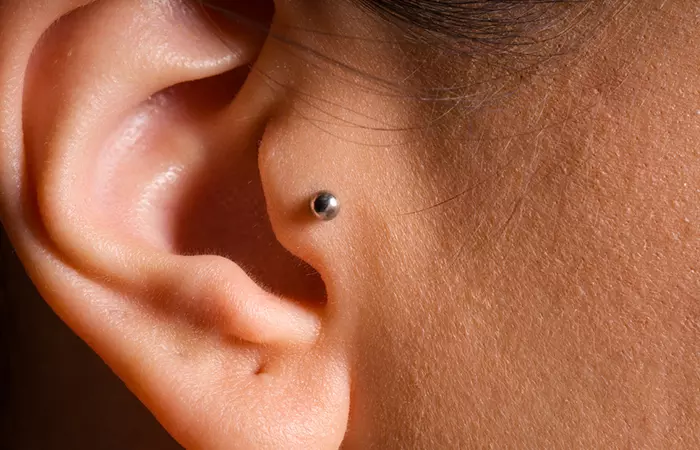
All open wounds, including cosmetic piercings, remain at risk of infection due to unchecked exposure to environmental elements. Here is a breakdown of potential causes of infections on tragus piercings (1):
- Incorrect Piercing Procedure
- Piercings done by inexperienced piercers using improper technique can damage the tissues and lead to an infection.
- Piercings that fit too tightly may cut off oxygen supply to the area, which promotes bacterial growth.
- Use of unsterile or contaminated tools that introduce bacteria into the piercing.
- Use of piercing jewelry made of cheap metal or alloy that causes a reaction on your skin.
- Improper Aftercare Methods
- Lack of a regular cleaning routine can allow bacterial growth in the area.
- Constantly touching the area with dirty hands may introduce bacteria in the still-healing piercing site.
- Use of harsh soaps, perfumes, or other chemical-based products may irritate a fresh piercing.
- Prolonged healing time of this cartilaginous piercing leaves the wound vulnerable for a longer period of time.
- Lifestyle Factors
- Exposure to chlorine and other impurities from swimming pools or contaminated water bodies.
- Regular use of headphones for work, music, gaming, etc., can cause friction in the area and aggravate the condition.
- A weakened immune system due to illnesses makes the body more vulnerable to infections.
- Allergic reactions to certain types of jewelry may lead to inflammation at the site of the piercing.
- Hairstyles that constantly snag at the piercing may irritate it and worsen the wound.
Cosmetic dermatologist, Dr. Schwarzburg states, “Because the tragus is cartilage, it is more prone to infection than areas like the earlobe and oftentimes gets infected more than once. If you have a mild infection and are able to treat it without any ongoing issues beyond 2 weeks, you may not experience another infection. However, some people may notice constant irritation regardless of treatment, in which case it is best to just take the piercing out.”
A lifestyle blogger who goes by the username redphillite on Medium talked about the experience of dealing with an infection in tragus piercing. To paraphrase, at first, the infection developed a swollen bump that was shedding skin and even bleeding. Based on the suggestion of family members, the writer decided to try harsh spirits to soothe the spot. “I decided to switch to surgical spirit. I know it isn’t advisable but I had to use something that worked. When I did the soaks, I would get it to ooze out blood and pus which was a good sign. It’s day three of the ooze and the bump has reduced in size as it peels (i),” they wrote. They continued, “I took some antibiotics and changed my jewelry from silver to gold and the bumps are all gone. Jewelry was fake AF!!”
While these are a few factors that may cause tragus piercing infection, there may be other unknown reasons. Some causes can also be specific to an individual. The question is, in that case, how does one identify if a tragus piercing is infected? The next section takes us through that.
Key Takeaways
- Tragus piercings are highly vulnerable to infections due to their exposed location where they constantly come in contact with environmental bacteria as well as hair and ear accessories.
- Some of the prominent causes of tragus piercing infections are incorrect and unhygienic piercing methods, metal allergies, improper aftercare, and lifestyle habits such as drinking and smoking that prolong the healing process.
- An infected tragus piercing can be identified by excessive redness, increasing pain, swelling, bleeding, or odorous pus discharge.
- Tragus piercing infections can be avoided by getting them done by an experienced professional, following proper aftercare, cleaning the piercing 2-3 times a day, avoiding skin-irritating products, and increasing hygiene measures.
How To Know If The Tragus Piercing Is Infected
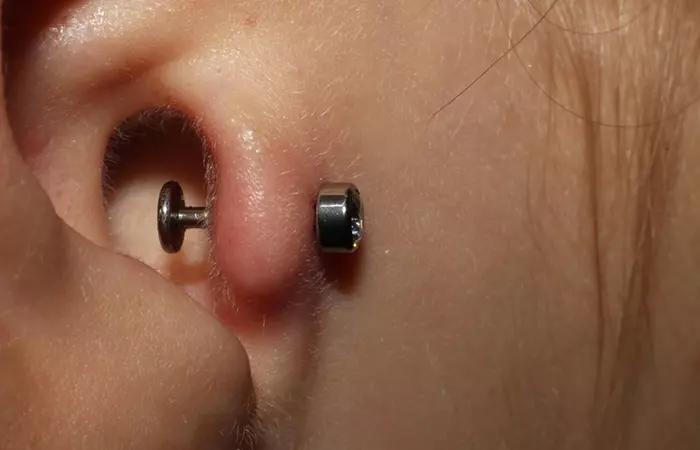
Any cartilage ear piercing is supposed to hurt and remain sore for a few days while it is fresh. The key is to understand if the soreness is normal or an infection. Here are some typical symptoms that you can take into account (2):
- Mild discomfort and throbbing
- Slight swelling
- Redness
- Sensitivity on the spot
- Clear or yellowish discharge from the piercing
The swelling should reduce within two days and the other signs may continue for about two weeks, gradually reducing in intensity.
However, you need medical attention if the symptoms continue to worsen and you notice or experience any of the following:
- Warm sensation at the spot continues to intensify
- Swelling persists beyond 48 hours
- Redness or inflammation continues after two weeks
- Severe pain
- Excessive bleeding
- Bumps form on the front or back of the piercing
- Odorous yellow or dark yellow pus discharges from the piercing
 Fun fact?
Fun fact?If you suspect an infection of tragus piercing, it is best to nip it in the bud. The next section tells you how to do that.
How To Treat An Infected Tragus Piercing
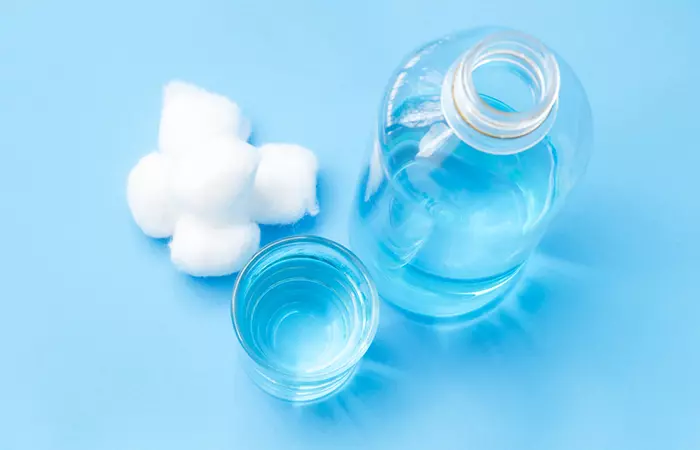
If you experience an unusual level of discomfort at the site of your piercing and conclude it might be an infection, you need to level up your hygiene practices and aftercare methods. Here is how to do it.
- Do Not Remove The Jewelry
Removing the jewelry might be the first instinctive response to the discomfort you feel. However, do not remove it as it may close the piercing, trap the infection inside, and obstruct a clean and proper healing process (3). If you feel removing the jewelry will comfort you best, talk to your piercer about it and let them remove it safely. - Clean The Piercing 2-3 Times Per Day
Most piercers ideally advise cleaning your piercing once a day for 4-8 weeks as per general standards. However, in case of an infection, you need to ensure extra hygiene to gently clean away any discharge or crustiness that may form in the area, 2-3 times a day. Professional piercers advise against homemade saline solutions to clean piercings as you may end up with an extra salty solution that may over dry the piercing site (3). A standard sterile piercing cleaning solution should be specifically labeled as suitable for wound washing, with its only major ingredient being 0.09% sodium chloride - Use A Warm Compress
Apply a warm compress to the piercing to reduce redness and swelling in the area (4). You may use a hot pack, a clean warm water-soaked towel, or a clean towel soaked in a warm infusion of chamomile tea bags.
Note: Avoid chamomile if you have a ragweed allergy. - Routinely Change Your Bed Sheets
Ensure your bedding and linens are always clean. Change your bedsheets every night if possible, especially if your piercing is oozing blood or pus discharge. This will minimize contact with bacteria. - Avoid Prolonged Contact With Water
Stay away from swimming pools or even natural water bodies. Avoid staying too long under the shower as well as it may encourage bacterial growth. Ensure the piercing site comes in contact with water only while you are cleaning it, so that exposure to moisture is as minimal as possible. - Avoid Irritating The Piercing Site
Refrain from constantly touching the piercing, especially without washing your hands. Also, temporarily steer clear from headphones, earphones, earbuds, and opt for hairstyles that do not constantly rub against the site, further aggravating it. - Maintain A Clean Lifestyle
Keep your body in the best condition to ensure a healthy immune system. Avoid drugs, smoking, or drinking alcohol, as these habits weaken your immunity and delay the wound healing process (5).
also adds, “It is extremely important to properly treat your tragus piercing if it gets infected. If left untreated, the infection can cause keloid scarring, which will leave you with a little bump on the piercing site. Keloid scars can be treated in some cases, though there is a chance that you will be stuck with it long-term.”
It is reassuring to know that there are certain measures you can take by yourself to treat a tragus piercing infection. But as they say, prevention is better than cure. Keep reading to discover tips on ensuring the piercing does not get infected in the first place.
How To Prevent A Tragus Piercing Infection
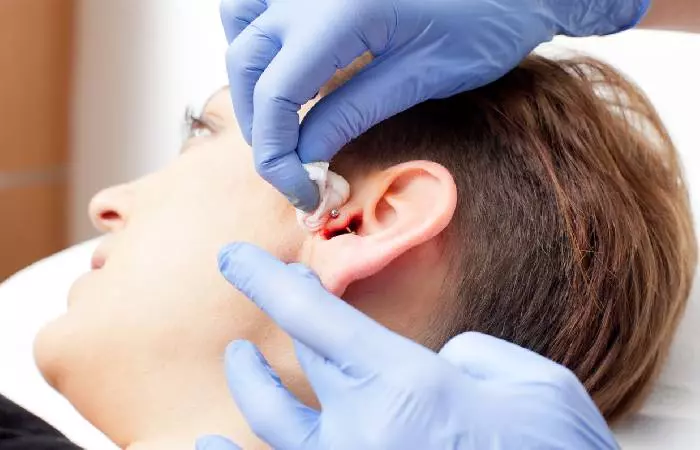
Taking a few extra precautions, being fully aware of how a new tragus piercing may affect your regular lifestyle, and planning your appointment accordingly is the first place to begin a safe and infection-free experience. Be mindful of the following.
- Research everything you can about the piercing studio and its employees. Go through their website, look at client reviews, and also note how often they perform tragus piercings. It is important that your piercing is performed by an experienced professional who will execute the process in the correct manner with minimal discomfort or risks. Note that an experienced piercer may charge more but that may protect you from infections better than cheap facilities.
- Avoid drinking alcohol or smoking for at least 48 hours before the piercing appointment.
- Ask your piercer for step-wise aftercare instructions. Follow them diligently and reach out to them for continued guidance if you feel your aftercare is not going as it should.
- Be aware of any metal allergies you might have. If you are unsure, better go for hypoallergenic materials such as titanium or stainless steel.
- Clean your piercings regularly and avoid harsh cleaning solutions such as rubbing alcohol, hydrogen peroxide, and strong ear care products. Also avoid thick antibiotic ointment.
- Ensure proper hygiene which involves washing your hands before cleaning the piercing, avoiding constantly touching it, changing sheets regularly, avoiding prolonged water contact, and so on.
- Avoid wearing tight headgear, such as hats, bands, scarves, etc. that press against the piercing. Keep headphones and earbuds clean, and avoid touching the area unnecessarily.
 Did you know?
Did you know?We insist on these treatment and prevention tips because a worsening infection can be extremely harmful to your overall health. Head over to the next section to find out how.
Potential Risks Of An Infected Tragus Piercing
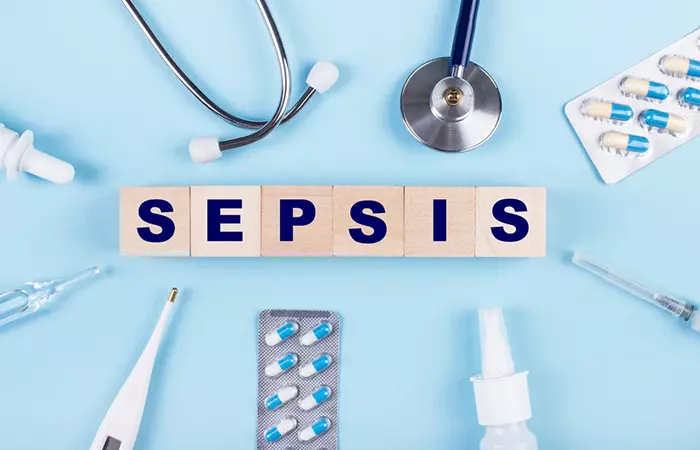
Upon early detection, most ear piercing infections can be managed with the help of the above-mentioned methods. However, in some cases, an infection may start out as a minor inconvenience but create bigger issues for your overall health if it is left untreated. The infection may seep into the bloodstream and turn septic, with an increased possibility of septic shock (6), (7). Here are some symptoms to identify sepsis or septic shock.
- Unusually high or low body temperatures
- Unexplained chills, fever, or shivering
- Breathlessness or increased breathing
- Feeling confused or disoriented
- Slurred or incomprehensible speech
- Weakened renal functions
- Muscle fatigue or pain
If you note any of the above symptoms after getting a tragus piercing, consult a healthcare professional immediately even if the signs of infection are not yet evident.
Infographic: Causes Of Tragus Piercing Infection And Treatment Tips
The tragus piercing is a sophisticated yet delicate form of ear modification that requires specialized care and attention. This comprehensive infographic lists the causes and explains ways to manage and prevent a tragus piercing infection. Check it out to learn how to protect your piercing and ensure a smooth, complication-free healing process.

Illustration: StyleCraze Design Team
It is unfortunate that one of the coolest ear piercings is so vulnerable to infections, which may discourage many from getting it. However, it is possible to not only effectively treat but also prevent them. All you need to do is invest some extra effort towards finding an experienced piercer, learning about piercing metal allergies, and keeping your piercing extra clean. You will also need to cut back on certain lifestyle habits such as drinking alcohol and smoking as they weaken your immune system and delay the healing process of your piercing. Further, it is important to note that an untreated tragus piercing may turn septic and may also lead to septic shock. Overall, we hope you take note of these key insights, put our tips to the test when you get your own tragus piercing, and have a memorable experience!
Frequently Asked Questions
Do tragus piercings get infected easily?
Yes. The tragus is a protruding cartilaginous part of the ear that protects the ear canal but itself remains exposed to bacteria in the environment. Additionally, hair, hair accessories like headphones and scarves, even ear accessories like headphones, may constantly rub against it and delay healing.
How do I disinfect a tragus piercing?
You may use a saline solution, usually provided or recommended by your piercer, to clean your infected ear piercing at least twice a day for 6-8 weeks. You may also use a mild antibacterial soap or make your own saline solution by adding 1/4th teaspoon sea salt to a cup of distilled water.
How do I know if my tragus piercing is getting rejected?
Tragus piercing rejection means that your body does not find the material in the piece of jewelry used to be suitable. It perceives it as a foreign object trying to attack the body, hence is trying to push it out. A few signs of the rejection are, the skin thinning around the jewelry and the metal becoming visible underneath, redness, irritation, or soreness.
A tragus-piercing infection can be physically and mentally disturbing. Watch the following video where a professional piercer tells you all about proper tragus piercing aftercare to ensure it heals properly without getting infected.
Personal Experience: Source
StyleCraze's articles are interwoven with authentic personal narratives that provide depth and resonance to our content. Below are the sources of the personal accounts referenced in this article.
(i) Drama With My Tragus Piercinghttps://medium.com/be-seen/drama-with-my-tragus-piercing-7cc1532e89e0
References
Articles on StyleCraze are backed by verified information from peer-reviewed and academic research papers, reputed organizations, research institutions, and medical associations to ensure accuracy and relevance. Read our editorial policy to learn more.
- Community Outbreak of Pseudomonas aeruginosa Infections Associated with Contaminated Piercing Aftercare Solution, Australia, 2021
https://www.ncbi.nlm.nih.gov/pmc/articles/PMC10521613/ - Case Report: Infected ear cartilage piercing
https://www.ncbi.nlm.nih.gov/pmc/articles/PMC1781501/ - Suggested Aftercare For Body Piercings
https://safepiercing.org/aftercare/ - Body Piercing
https://www.ncbi.nlm.nih.gov/pmc/articles/PMC1496593/ - Factors Affecting Wound Healing
https://www.ncbi.nlm.nih.gov/pmc/articles/PMC2903966/ - Sepsis and septic shock
https://www.ncbi.nlm.nih.gov/pmc/articles/PMC5538252/ - Body piercing with fatal consequences
https://www.ncbi.nlm.nih.gov/pmc/articles/PMC3062280/
Read full bio of Dr. Schwarzburg
Read full bio of Aparna Harry
Read full bio of Subhrojyoti Mukherjee
Read full bio of Joyce Joyson










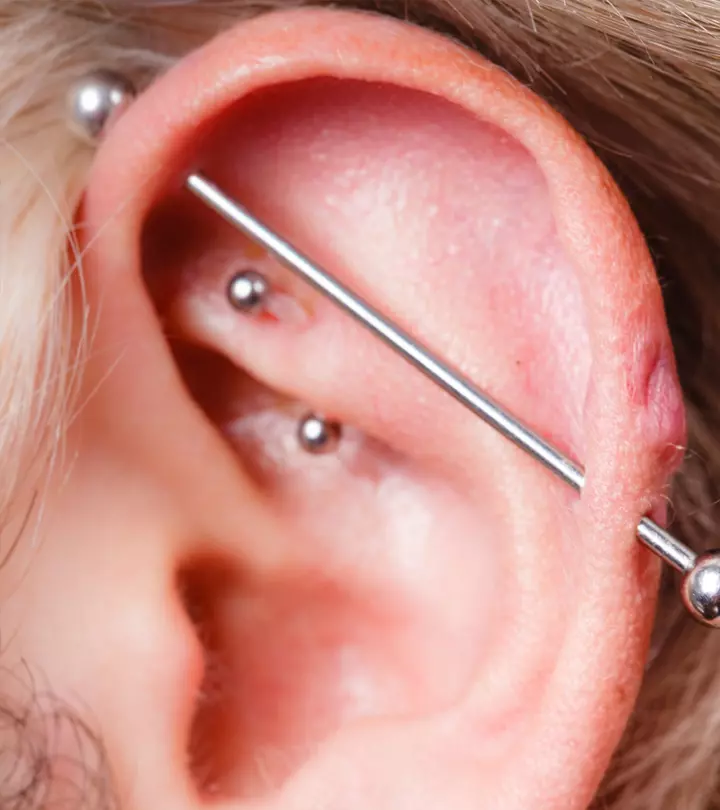

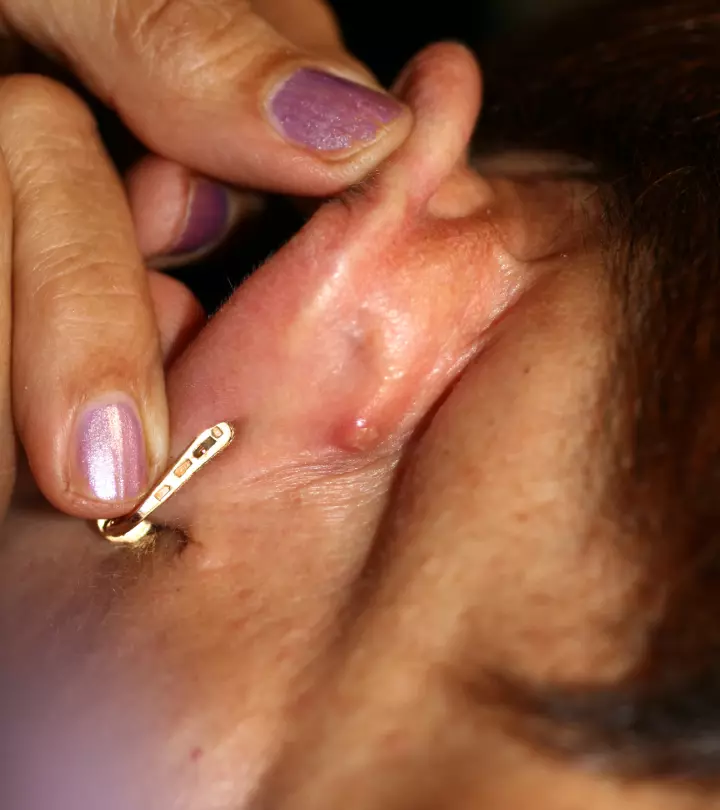














Community Experiences
Join the conversation and become a part of our empowering community! Share your stories, experiences, and insights to connect with other beauty, lifestyle, and health enthusiasts.